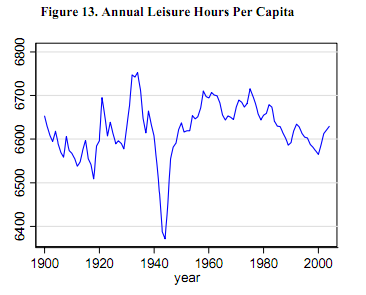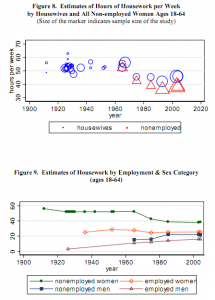Earlier in the week I argued that coordination problems, in the same vein as the Prisoner’s Dilemma, potentially lead to suboptimal outcomes in terms of the trading off productivity gains for leisure instead of increased incomes.
A diligent reader queried one of the claims made in that post – that leisure time has been relatively constant since 1900, and time spent on home production activities (cooking, cleaning etc) has actually slightly increased.
First, the evidence it pretty clear for this claim from many independent source. Below are a set of graphs from this study showing the total leisure time per year per capita since 1900, and the time spent on housework. We can clearly see the declines in hours by women being taken up by men in the final panel.
How could this possibly be, given the image we all hold of the housewife in the early decades of last century slaving away all hours of the day on domestic chores?
There are two main reasons.
1. The reduced occupation rates of households. This means there is more house per person to clean, and fewer people to enjoy each home cooked meal. In the past one housekeeper would cooking, cleaning, mend clothes and so on for a family (or extended family of say 6+ people) and work about 50 hours a week at these domestic tasks. But now there are more single occupant households and small families, with a similar number of tasks per household – therefore more chores per capita.
2. The standards for household chores increase dramatically as each task becomes easier.
The following excerpt from The Big Switch explains how the electrification of household chores failed to deliver its time-saving promise due to rebound effects in the form of evolving social norms. Ironically, these effects are completely in keeping with the Law of Demand and also happen at a micro level. As the cost (in time and effort) of household chores declined, we demanded more of them.
The utopian promise of electricity seemed within reach inside the home. Many women believed that new appliances like vacuum cleaners and washing machines would, as General Electric advertised, transform their homes from places of labour into places of ease. The home would become less like a sweatshop and would become, as Thomas Edison predicted in a 1912 article on “The Future of Women,” “a domestic engineer [rather] than a domestic labourer, with the greatest of handmaidens, electricity, at her service.” The first widely purchased appliance designed specifically for housework, the electric iron, seemed to fulfil this expectation. Women no longer had to heat a heavy wedge of cast iron over a hot stove and then drag the red hot chunk of metal over a piece of clothing, stopping frequently to reheat it. They could just plug in a lightweight appliance into the wall. During the first two decades of the century, scores of homemakers swapped their old-fashioned irons for modern electric ones. A photograph of the time shows a General Electric employee standing proudly beside a small mountain of discarded flat irons.
As it turns out, though, the electric iron was not quite the unalloyed blessing it first appeared to be. By making ironing “easier,” the new appliance ended up producing a change in the prevailing social expectations about clothing. To appear respectable, men’s and women’s blouses and trousers had to be more frequently and meticulously pressed than was considered necessary before. Wrinkles became a sign of sloth. Even children’s school clothes were expected to be neatly ironed. While women didn’t have to work as hard to do their ironing, they had to do more of it, more often, and with more precision.
As other electric appliances flooded the home through the first half of the century – washing machines, vacuum cleaners, sewing machines, toasters, coffee-makers, egg beaters, hair curlers, and, somewhat later, refrigerators, dishwashers and clothes dryers – similar changes in social norms played out. Clothes had to be changed more frequently, rugs had to be cleaner, curls in hair had to be bouncier, meals had to be more elaborate, and the household chine had to be more plentiful and gleam more brightly. Tasks that once had been done every few months now had to be performed every few days, When rugs had had to be carried outside to be cleaned, for instance, the job was done a couple of times a year. With a vacuum cleaner, it became a weekly or even daily ritual.
Tips, suggestions, comments and requests to [email protected] + follow me on Twitter @rumplestatskin

